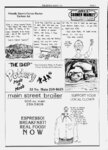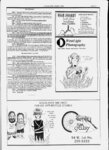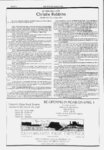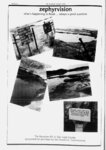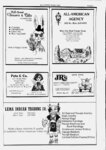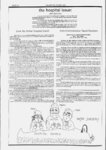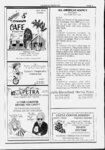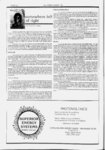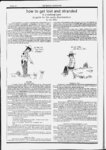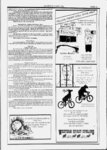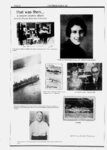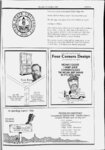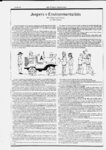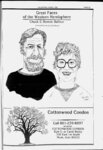| OCR Text |
Show PAGE 14 THE ZEPHYR MARCH 1991 S2 how to get lost and stranded in a national park (a guide for the easily disorinented) by Jim Stiles Arches National Park Is a small park compared to many. At about 70,000 acres, It Its topography Is not nearly as rugged or Is dwarfed by neighboring Canyonlands. or of Maze districts that Needles as the park. But Its confusing enough. For each confusing I of the eleven years was employed as an Arches seasonal ranger, I spent a part of that season looking for lost hikers and rescuing stranded climbers. It was my Job, so I had to. The National Park Service has spent a small fortune trying to warn and educate the public about the risks Inherent In visiting a park. They have provided colorful glossy brochures with long lists of rules and regulations that no one reads. They post wooden signs at every potential danger spot that tourists spilt with an ax and take back to their campsites as firewood. Rangers with graven faces repeat those dangers to bored visitors at the evening campfire programs. Nothing works. So It occurred to me, the government people are going about this all wrong. Let's little a reverse psychology here, eh? If Its the nature of human beings to disregard all try rules and regulations, why not deal with the problem on that level? Therefore I am pleased to present my guide to getting lost and stranded, based on over a decade of experience, generously laced with humorous anecdotes. stupid, but are convinced that their superior Intelligence and acute sense of direction will bring them home. The second group Is considerably older, already overwhelmed by the strangeness of their surroundings, with no Intention of doing anything foolhardy whatsoever. But not only do these folks have a poor sense of direction, I would say, In many cases, they have no sense of direction at all. In the second case. It Is a simple matter of taking a wrong turn, In a direction exactly opposite the route back to the tralihead, that leads to disaster. Consider the famous "Nellie Case of 1985 (see sidebar story). All Nellie had planned was a hike to Landscape Arch on a trail that Is eight feet wide and traveled by 100,000 walkers a year. When she reached the arch, she started up the short loop trail that passes beneath Landscape and then Joins the main trail again barely 100 yards north of the starting point But for reasons no one can possibly provide ("fools give you reasons; wise men never try), Nellie turned north, headed away from the tralihead, toward Double O Arch, on a trail that the park brochure describes as "primitive. What Nellie did next falls under the next heading... JTM uoT 6i sune AK fbfc wHo' XD , PART ONE 1: Actually be lost you plan to get lost, please make sure that you are lost That may sound so let me provide an example. In 1977, a small group of hikers, Including the confusing, noted photographer Philip Hyde, reported to me that theyd discovered a backcountry campsite. It appeared to have been abandoned - as If the person had wandered off from the site and never returned. Hyde led me to the campsite, and It was odd Indeed. The large pack lay open, a copy of Desert Solitaire sat face down on the sand turned to page S3, a cookstove set to one side. There were no tracks whatsoever, but strong winds earlier In the day could easily have obliterated them. We decided to Instigate a search. It should be noted that rangers for the most part love search operations. While they take the situation seriously and with great concern, It also means they get to break their normal routine and wander around In the backcountry, In places they rarely vlstt. They also get paid overtime. About eight of us laid out a grid of the area, and spent the next day and a half exploring every side canyon, every alcove, the bottoms of every cliff, looking for (we were convinced) the mortal remains of an unknown camper who had taken his last hike. Meanwhile, back at HQ, the chief ranger was attempting to run down our only lead. At the bottom of the abandoned pack, Id found a shred of paper. It contained the name of a doctor and the town "Springfield on It It made no mention of a state, and since about every state In the country has a Springfield In It the task of tracking this doctor down was going to be time consuming, If not Impossible. In the field, the rangers carried on, with no sign whatsoever of our missing man. On Sunday night I was advised by radio to meet a contingent of U.S. Army tracking dogs and their trainers at 0600 hours (6 a.m.) the following morning. I was up at five, dressed, packed and ready to go, when I heard the chief ranger call me on the radio. If "236...212 (radio call numbers) "This Is 236, I replied. "Disregard plan to meet tracking dogs at 0600. The hiker has been found. "10-4I said. "Where did you find him?" There was a long pause. "We found him In Springfield, Illinois. Huh? TWo weeks earlier, our "lost hiker had wandered away from the campsite, and then couldnt find his way back to It Rather than continue his search for camping equipment worth at least $500, he abandoned It When he left the park, the visitor center was closed, so he stuffed a note under the door which was dutifully filed 1" hand-scribbl- ed away by a park volunteer and forgotten. The next day, I carried this Jerk's pack 212 miles to the campground. Eventually, we shipped the pack, at government expense, to the man from Illinois. May his armpits be Infested with the lice from a Junkyard dog. (16-2- 5), Getting Lost - Step 1 two distinct There are very types of lost hikers. The first type Is usually young athletic, and overconfident They are generally aware that what they're doing Is Staying Lost - Step 2 The Idea here Is: once you realize youre lost dont do something logical like sit down, kick off your shoes and wait for someone to find you. No Indeed. If you really want to provide a challenge, keep moving. Abandon common sense. In Nellies case (Nellie, by the way, was 72 years old at the time), Instead of retracing her steps back down an established trail, she decided to leave the trail altogether y. and travel And why not? What better way to see the park's lesser known beauty spots? She threaded her way through sandstone fins and over rocky ledges and down sandy hills until, Just at sunset, she came across another trail, the primitive Fin Canyon Loop Trail. This trail could have led her back to Landscape Arch and safety, but after following It for a hundred yards or so, she abandoned It as well. Where was she headed? What was her plan? WelL.I couldnt tell you. cross-countr- Adding Insult Arches Is desert country to Injury - Step 3 - hot and dry. It seldom rains, but when It does, natural potholes In the sandstone will fill with water and retain It for weeks. It may look a little scummy, there may be strange creatures doing the backstroke In It, but that water can be a llfesaver. However. If youre already lost, and loving every minute of It, and youd like to add serious dehydration to your list of troubles, by all means, avoid the water at all costs. In the late '50s, a man and his dog got confused In the tangle of canyons at Natural Bridges. Thinking he was In Armstrong Canyon, he turned south down White Instead. For two days, he staggered down the canyon under a fierce June sun. His dog ran from one pool to the next, lapping up the water and living a dog's life, his thirst happily quenched. The man (supposedly the smarter of the two) refused however to touch the algae-lad- en liquid. He swore hed rather die than drink from those slimy cesspools. When Bates Wilson and a search team from the park finally caught up with him, the man was delirious from dehydration. They tried to keep him alive through the remainder of the afternoon, but It was Just too late. That night, the man who swore he'd rather die than drink pothole water kept his word. Hallucinations or Seeing Is Not Believing - Step 4 say psychedelic drugs ust arent what they used to be? Heres an answer to your prayer. If youve followed these Instructions carefully - get lost, enoy the searing heat, refuse to drink water - I promise that In time, the hallucinations will come. When we last left Nellie, she'd left the trail again, headed for parts unknown. As darkness closed In, what drew her In that direction was not a hallucination, but something almost as misleading. Nellie saw lights - civilization, she figured. To her, It appeared Just over the next ridge, so she decided to stroll on over and pronounce herself "found. What Nellie saw were the headlights of trucks and cars on miles twenty-fiv- e miles of rugged, rocky terrain, cut by canyons and north; twenty-fiv- e (fry washes. Nellie had a cigarette lighter In her purse; she lit It and waved the flame over her head. She continued to send her distress signal until shed used up all the butane. For the life of her, Nellie could not understand the thoughtlessness of those people on the highway. moving easL She was now out of the park and You |



